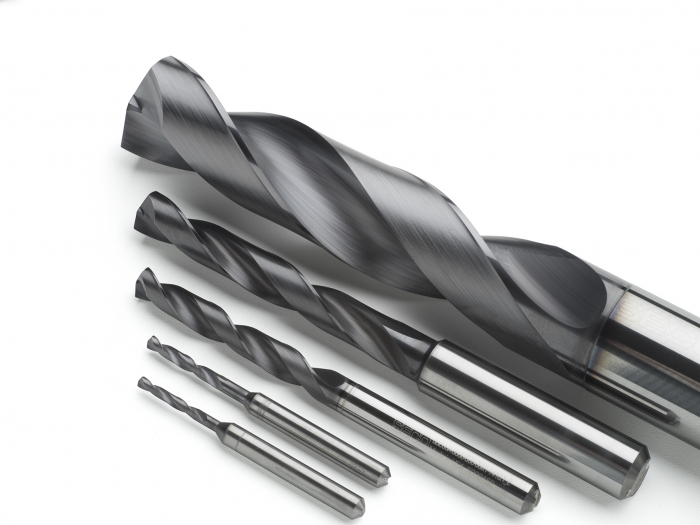Drilling has long been the cornerstone of the machining process, consuming roughly 50 percent of all tools and creating 75 percent of all chips. So it comes as no surprise that shops interested in reducing costs and increasing productivity should look first toward the full optimization of their holemaking processes with today’s advanced solid-carbide and indexable-insert drill technologies.
The most important target for improvement is durability – when drills fail, manufacturing stops. Tool manufacturers have sought a variety of ways to make drills last longer, often by increasing the strength of the drill’s material or imparting a different surface finish. For example, polished drill flutes reduce fatigue by increasing strength. Likewise, advanced drill flutes and flute exit designs evacuate chips from the hole as quickly as possible, and in doing so allow for faster drilling speeds and increased tool life.
The most frequent factor in drill failure is coolant. Any failure in chip evacuation or heat reduction may cause unacceptable slowdowns or, even worse, scrapped workpieces. The correct amount of coolant is critical, as is its pressure, especially as machine tool OEMs move toward increased sustainability with minimum quantity lubrication (MQL) coolant systems.
For its latest generation of solid-carbide drills, for instance, Seco paid particular attention to coolant delivery in the design of its new Feedmax –P drills. They have coolant holes directly adjacent to the cutting edge – precisely where it is needed most. Heat can also be reduced by decreasing the size of the land margins, which limits the friction caused when the drill, as opposed to the cutting edge itself, comes in contact with the hole surface.

Seco paid particular attention to coolant delivery in the design of its new Feedmax –P drills. Photos courtesy of Seco Tools
In addition to controlling heat, improving the surface finish of solid-carbide drill tips and cutting edges improves the quality of the honed edge. The finished surface holds its hone better, which would otherwise reflect any microscopic errors left by the initial grinding operation. The shape of the cutting edge itself also requires careful consideration – for the strongest edges, cutting tool OEMs have moved away from radial edges to straight geometries, which improves strength and allows for much more aggressive feeds.
Faster drilling feed rates generate more chips, necessitating advances in flute design for equally fast evacuation. For solid-carbide drills, this means larger flutes that offer more room for chips. While this might otherwise weaken the drills, tapering the flutes can make them even stronger than traditionally designed flutes.
That strength can also remain undiminished for longer periods of time thanks to advances in coatings. Materials like the titanium aluminum nitride (TiAlN) coating on the Feedmax -P drills cause microstructural changes that strengthen the drill’s materials and allow it to resist oxidation at high temperatures. For drill surfaces, the coating creates feed barriers that outperform those of typical TiN coatings. In combination with larger flutes and optimized cutting edges, this results in solid-carbide drills that can be anywhere from 20 to 100 percent better in terms of productivity and total tool life.
Like solid-carbide drills, indexable insert drills have experienced the same kinds of radical design changes and improvements. Even the smallest details, such as the location of coolant holes, have been tweaked in these latest designs. Of course, the most important changes have happened at the very front of the drills, particularly with respect to the area where chips make contact with the drill body after being broken off by the cutting edge.
Fast moving chips constantly hit the walls of the drill body flutes, causing the surfaces to crater and erode. Generally, a few microns of nickel-Teflon will provide surface protection, but a far superior solution is laser hardening. This process involves quickly heating a ferrous metal with a moving laser then utilizing the self-quenching nature of these materials to cool it. The resulting martensitic structure of the metal surface is just as strong as traditional coatings, at 60 HRC, but the 0.3 mm to 0.5 mm of hardened material is much thicker, significantly extending the life of the tool.
In addition to the application of laser hardening, Seco has also further refined the flute geometries of its new Perfomax indexable-insert drills. Even a difference of one or two degrees in the helix angle of flutes can create dramatic improvements in drill performance, while extended flute radii keep chips from escaping. The flutes also incorporate friction-reducing wave patterns on their surfaces to increase lubricity and further streamline chip evacuation.

The flutes on Perfomax indexable-insert drills incorporate friction-reducing wave patterns on their surfaces to increase lubricity and further streamline chip evacuation.
Outside of the flutes, additional radial clearance and grooved surfaces on the drill body keep noncutting surfaces away from the hole, which reduces chip jamming and drill damage. Even the shanks of these drills have new performance-improving features, such as chamfered flats that eliminate the markings of setscrews from holders left on the flats of drill body shanks, as well as large corner radii in the insert pockets for additional strength and rigidity.
Thanks to today’s advanced holemaking tools like Seco’s Feedmax –P and Perfomax drills, shops can handle nearly all holes with diameters smaller than 59 mm. When dealing with holes between 2 mm and 20 mm, especially those with diameter-to-length ratios greater than 5:1, the solid-carbide drills are the ideal choice. The indexable-insert drills create much larger holes, between 15 mm and 59 mm up to 5:1 and are suitable for roughing applications.
Choosing the correct drill also requires considering the material being drilled and the desired type of hole. For the most aggressive feed rates in cast iron and steel, manufacturers turn to solid-carbide drills and their two effective flutes, though new geometries and coatings make it possible to use these drills for stainless steel and other hard materials. Indexable-insert drills are particularly useful for applications like angled entries, interruptions, boring and circular interpolation in virtually any material. The latest models of Seco Perfomax inserts, for instance, use niobium nitride (NbN) coatings for cutting titanium and high-temperature alloys.
Shops that machine high volumes of a single material can afford to use a single type of drill. For those who never know what’s coming in the door next, the dynamic duo of solid-carbide and indexable-insert drills is the answer. Between the two drill types, any drilling application can be performed with ease at the highest possible levels of productivity.
Related Glossary Terms
- alloys
alloys
Substances having metallic properties and being composed of two or more chemical elements of which at least one is a metal.
- boring
boring
Enlarging a hole that already has been drilled or cored. Generally, it is an operation of truing the previously drilled hole with a single-point, lathe-type tool. Boring is essentially internal turning, in that usually a single-point cutting tool forms the internal shape. Some tools are available with two cutting edges to balance cutting forces.
- clearance
clearance
Space provided behind a tool’s land or relief to prevent rubbing and subsequent premature deterioration of the tool. See land; relief.
- coolant
coolant
Fluid that reduces temperature buildup at the tool/workpiece interface during machining. Normally takes the form of a liquid such as soluble or chemical mixtures (semisynthetic, synthetic) but can be pressurized air or other gas. Because of water’s ability to absorb great quantities of heat, it is widely used as a coolant and vehicle for various cutting compounds, with the water-to-compound ratio varying with the machining task. See cutting fluid; semisynthetic cutting fluid; soluble-oil cutting fluid; synthetic cutting fluid.
- fatigue
fatigue
Phenomenon leading to fracture under repeated or fluctuating stresses having a maximum value less than the tensile strength of the material. Fatigue fractures are progressive, beginning as minute cracks that grow under the action of the fluctuating stress.
- feed
feed
Rate of change of position of the tool as a whole, relative to the workpiece while cutting.
- flutes
flutes
Grooves and spaces in the body of a tool that permit chip removal from, and cutting-fluid application to, the point of cut.
- grinding
grinding
Machining operation in which material is removed from the workpiece by a powered abrasive wheel, stone, belt, paste, sheet, compound, slurry, etc. Takes various forms: surface grinding (creates flat and/or squared surfaces); cylindrical grinding (for external cylindrical and tapered shapes, fillets, undercuts, etc.); centerless grinding; chamfering; thread and form grinding; tool and cutter grinding; offhand grinding; lapping and polishing (grinding with extremely fine grits to create ultrasmooth surfaces); honing; and disc grinding.
- hardening
hardening
Process of increasing the surface hardness of a part. It is accomplished by heating a piece of steel to a temperature within or above its critical range and then cooling (or quenching) it rapidly. In any heat-treatment operation, the rate of heating is important. Heat flows from the exterior to the interior of steel at a definite rate. If the steel is heated too quickly, the outside becomes hotter than the inside and the desired uniform structure cannot be obtained. If a piece is irregular in shape, a slow heating rate is essential to prevent warping and cracking. The heavier the section, the longer the heating time must be to achieve uniform results. Even after the correct temperature has been reached, the piece should be held at the temperature for a sufficient period of time to permit its thickest section to attain a uniform temperature. See workhardening.
- helix angle
helix angle
Angle that the tool’s leading edge makes with the plane of its centerline.
- indexable insert
indexable insert
Replaceable tool that clamps into a tool body, drill, mill or other cutter body designed to accommodate inserts. Most inserts are made of cemented carbide. Often they are coated with a hard material. Other insert materials are ceramic, cermet, polycrystalline cubic boron nitride and polycrystalline diamond. The insert is used until dull, then indexed, or turned, to expose a fresh cutting edge. When the entire insert is dull, it is usually discarded. Some inserts can be resharpened.
- interpolation
interpolation
Process of generating a sufficient number of positioning commands for the servomotors driving the machine tool so the path of the tool closely approximates the ideal path. See CNC, computer numerical control; NC, numerical control.
- land
land
Part of the tool body that remains after the flutes are cut.
- lubricity
lubricity
Measure of the relative efficiency with which a cutting fluid or lubricant reduces friction between surfaces.
- titanium aluminum nitride ( TiAlN)
titanium aluminum nitride ( TiAlN)
Often used as a tool coating. AlTiN indicates the aluminum content is greater than the titanium. See coated tools.
- titanium nitride ( TiN)
titanium nitride ( TiN)
Added to titanium-carbide tooling to permit machining of hard metals at high speeds. Also used as a tool coating. See coated tools.

